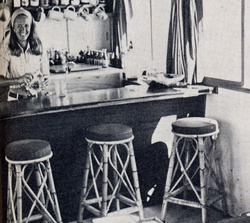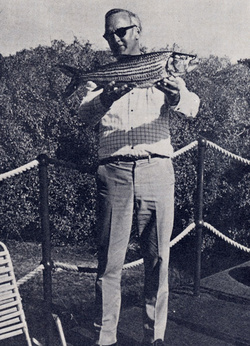Venturing the Okavango Delta on river boat Sitatunga
From Grootfontein via Caprivi Strip to Shakawe fishing camp: 600 km by Landrover. Boarding riverboat Sitatunga - venturing the Okavango Delta.

There, we introduced ourselves to Major Kruger of the S.A. Police and to other Senior State officials and we were given the go-ahead to continue our journey by road along the Okavango River and across Caprivi to Shakawe, a journey of some 600 km from Grootfontein that took as 13 hours to complete. We arrived at the fishing camp at Skakawe after dark, to be met by Mr. Piet Blignaut, manager of the camp, who provided a welcome meal and put us into three of his riverside guest-tents. And on Saturday, June, I, Tim and June Liversedge arrived at Shakawe from Sepopa in two pick-ups with four-wheel drive to take us to the waiting houseboat. Our road journey, along tortuous Botswana sandtracks, ended on the river bank at Sepopa, and from there we were taken in two outboard launches another 20 km downriver, where we boarded the Sitatunga at a lonely and peaceful spot near the confluence of a network of channels through the swamps. We were all immediately struck by the ingenuity of design of this extraordinary riverboat, which had been built in sections in Johannesburg, transported 3000 km by low-loaders through S.W.A. and along the route we had just followed, and then launched, assembled and completed at Shakawe - the vessel's home base. With an all-up weight of about 20 tons, the shallow-draught Sitatunga is 15 m long with a beam of just under five metres. The sun-deck, or observation deck, is five metres above the water, to afford the vessel's paying guests a clear, unimpeded view of the swamps and the wildlife that abounds there. The Sitatunga, which takes its name from the elusive swamp-dwelling antelope that has its home in the reeds and papyrus that characterize the area, is powered by a 75-h.p. Volvo Penta inboard-outboard motor which gives it a still-water speed of about six knots. Its two auxiliary outboard boats are towed astern and are used mainly for fishing expeditions and for transhipping passengers and gear. The living quarters in the Sitatunga are on the lower deck and comprise three double guest cabins, each with access to a shower/toilet cubicle, apart from the Liversedge's cabin directly below a fully-equipped control room at the fore-end of the vessel. On the second deck, adjoining the control cabin, is a large room with dining, lounge and bar areas, behind which is a full-sized kitchen equipped with a gas range and two big gas-fuelled refrigerators. Three Botswanamen make up the crew. At overnight stops, usually alongside one of the myriad islands in the swamps, these inland sailors pitch their bell tent ashore. There they can make campfires and cook their own meals, often including part of the day's catch of tiger-fish, barbel and bream.

